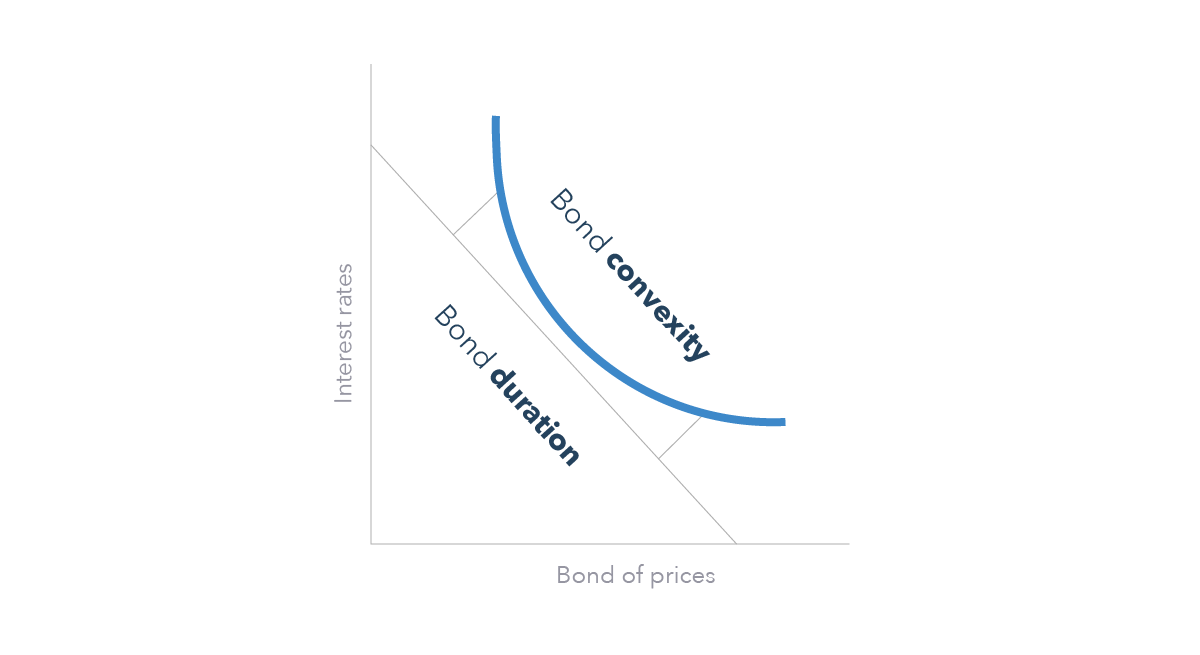Learn more about forex
Find out more about forex trading, including what the spread is and how leverage in forex works.
Bond convexity is a measure of the relationship between a bond’s price and interest rates. It is used to assess the impact that a rise or fall in interest rates can have on a bond’s price – which highlights a bond holder’s exposure to risk.
Find out more about forex trading, including what the spread is and how leverage in forex works.
To understand convexity, we need to look at what is meant by bond duration – the average time it takes to receive back the cash flows of a bond. It is a useful concept in bond trading because by comparing bond durations, traders may be able to anticipate the degree of price change in a bond after a change in interest rates.
As a rule of thumb, if interest rates increase or decrease by 1%, a bond’s price will decrease or increase 1% for every year of its duration. For example, if a trader had just bought a 10-year bond and interest rates rose by 1%, the bond’s value would likely drop by 10%. If interest rates begin to rise above the return rates of the bond, bond traders may wish to sell.
This is because the bond holder will receive a less attractive rate than they had anticipated when they first bought the bond. In a market with rising interest rates, bond holders look to enter into newly-issued bonds that are giving higher yields.
A change in interest rates can affect the duration of the bond, because an increase in interest rates mean that it would take a longer time for the bond trader to realise a profit. Equally, a drop in interest rates means that it would take a shorter time for a bond trader to realise their full return.
Convexity hopes to correct the disparity between bond prices and interest rates, and it achieves this by accounting for any effect that interest rates can have on the bond’s duration.
The below graph demonstrates the relationship between bond duration and convexity. The bond’s duration is represented by the straight line plotted between ‘interest rates’ and ‘bond prices’. In contrast, the convexity is the curved line that more accurately predicts any changes in a bond’s price in line with interest rate changes.

Generally speaking, there are two forms of convexity: positive and negative.
Traders tend to want positive convexity as it means that bond prices are less sensitive to any changes to interest rates. Negative convexity often works against traders because it means that there will be larger price fluctuations if interest rates rise.
Discover how to trade with IG Academy, using our series of interactive courses, webinars and seminars.
New client: +65 6390 5133 or accountopening@ig.com.sg
Clients: Help and support
![]()
WhatsApp: Click here
IG | Sitemap | Terms and agreements | Privacy | Security | IG Community | Refer a friend | Cookies | About IG
Disclaimer:
All forms of investments carry risks and trading CFDs may not be suitable for everyone. CFDs are leveraged instruments and can result in losses that exceed deposits, so please ensure that you fully understand, and are aware of, the risks and costs involved. Refer to the Risk Disclosure Statement and Risk Fact Sheet.
IG Asia Pte Ltd (Co.Reg.No. 200510021K) is regulated by the Monetary Authority of Singapore and holds a capital markets services licence for dealing in capital markets products that are over-the-counter derivatives contracts and is an exempt financial adviser.
IG provides an execution-only service. The information in this advertisement does not contain (and should not be construed as containing) investment advice or an investment recommendation, or an offer of or solicitation for a transaction in any financial instrument. IG accepts no responsibility for any use that may be made of these comments and for any consequences that result. You should consider your specific investment objectives, financial situation or particular needs before making a commitment to trade, including seeking advice from an independent financial adviser regarding the suitability of the investment, under a separate engagement, as you deem fit.
The information on this site is not directed at residents of the United States or Belgium and is not intended for distribution to, or use by, any person in any country or jurisdiction where such distribution or use would be contrary to local law or regulation.
This advertisement has not been reviewed by the Monetary Authority of Singapore.
CFDs are leveraged products. CFD trading may not be suitable for everyone and can result in losses that exceed your deposits, so please ensure that you fully understand the risks involved.